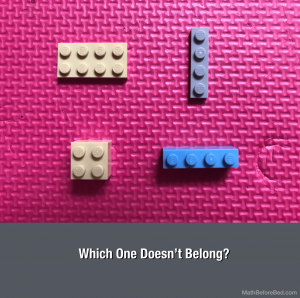Have you ever tried ‘ Which One Doesn’t Belong?’ (WODB) in your classroom?
WODB is a short, number talk used to get students thinking before beginning a daily lesson or math activity. Students are shown a picture like the example attached below (from mathbeforebed.com). Students take a close look at the picture and decide which object they think does not belong. After sharing their ideas, students are asked to explain their thinking to justify their answer. Here is why we love WODB in our Kindergarten class:
There are no wrong answers
This gives students the confidence to share their thoughts and encourages them to take risks in their learning.
WODB shows students that there are multiple ways of solving problems
I am finding that aside from building confidence in students’ attitudes towards math, this activity builds community. Students typically begin with a strong opinion on why their answer is correct, but begin to understand and uncover the varying perspectives of their peers. It is also a great activity to practice turn taking, active listening and showing kindness towards others with different ideas.
There are multiple entry points
This activity is inclusive and allows students to use their own mathematical language to describe which one they believe does not belong. Students can participate in this activity regardless of their understanding of specific math concepts. In Kindergarten, with students ranging in various stages of development – this activity gives myself and my DECE partner a window into their thinking.
WODB promotes mathematical thinking and the use of mathematical language
When justifying their answer, students begin to use math words like bigger, smaller, shorter, taller, less, more and begin to use the names of shapes, numbers or symbols they are learning about. Students can activate their prior knowledge and apply their current knowledge while they work with educators to extend their knowledge. I often reframe what students are saying and repeat it back to them. For example, in the picture shown below a student may share that they think the “blue” one does not belong, “because it’s blue and the others are not” and I may say, “(student name) thinks that the blue rectangle piece does not belong”.
WODB can be used in any grade level
While I am currently enjoying this activity in Kindergarten, I think about all the ways this activity could be used with students of any age. As students learn new concepts, WODB could include pictures of fractions, decimals, equations and more. When students get comfortable engaging in WODB activities, they can even begin to create some of their own pictures to challenge their peers to think critically.
Which one do you think does not belong?



